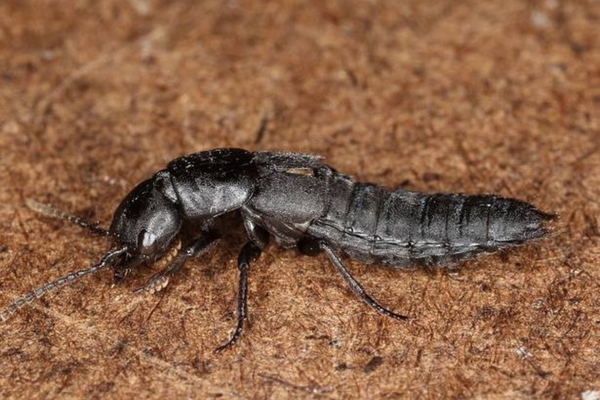How to Identify Rove Beetles?
Adult rove beetles are typically smaller than 2 cm in length. They are usually black or brown with slender bodies and short front wings. Unlike other beetles, rove beetles angle their abdomens upward when running or when startled.
Signs of a Rove Beetle Infestation
Look for rove beetles under plants, trash bins, rocks, and vegetation. Indoors, they may hide in basements. Because they move quickly, you might only catch glimpses of them.
How to Remove Rove Beetles
For minor infestations, vacuum up rove beetles as soon as you detect them. For larger infestations or persistent problems, contact a professional pest control service.
How to Prevent Rove Beetles from Invading
- Remove decaying organic matter near the home.
- Seal any cracks or openings around windows and doors to limit access.
Habitat, Diet & Life Cycle
Rove Beetle’s Habitat
Rove beetles nest in decaying organic matter and soil. Outdoors, they hide under leaf litter, rocks, and plants. Indoors, they are commonly found in basements.
Rove Beetle’s Diet
They feed on small insects found on crops and on dead animals.
Rove Beetle’s Life Cycle
The rove beetle life cycle includes four stages: eggs, larvae, pupae, and adults. Eggs are laid in decaying matter or soil. Development is rapid, and adults can live for extended periods.
Why Do I Have Rove Beetles?
Rove beetles often enter homes through cracks while searching for decaying organic matter, leaf litter, debris, or plants. These materials are commonly found in basements or near foundations.
How Serious Are Rove Beetles?
Rove beetles are generally beneficial because they feed on pest insects and decomposing material. However, they can be unsightly indoors and may bite if handled. Their nocturnal and fast-moving nature makes infestations difficult to detect. While small infestations can sometimes be managed by vacuuming, professional pest control is recommended to fully remove and prevent future issues.

